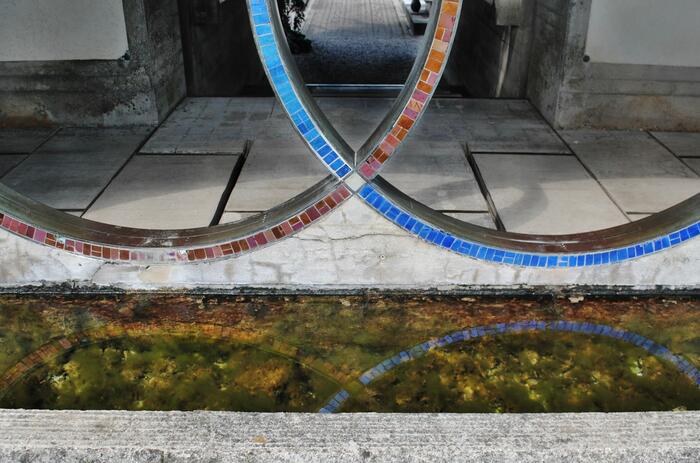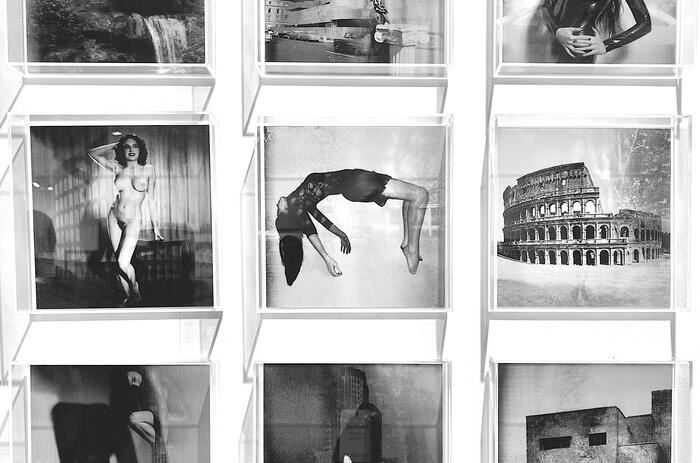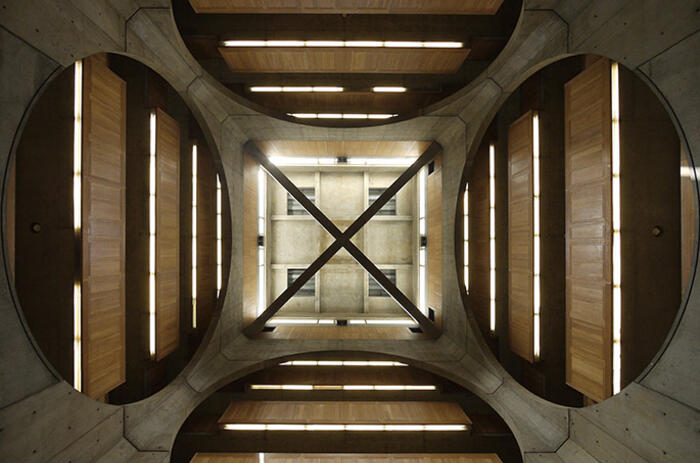EXTEND THE WHITE OF THE STATUES TO THE WALLS AND CUT THE BLUE OF THE SKY
Carlo Scarpa designed the Gipsoteca - plaster museum - for Antonio Canova in Possagno between 1955 and 1957. An expansion of the museum that houses the molds of the great Italian neoclassical sculptor, we keep a copy of his Three Graces in front of the Sarmiento Historical Museum in Buenos Aires.

After Canova's death in 1822, in the interest of his brother Sartori, and his plaster models having been preserved in his Roman studio, a basilica designed by Francesco Lazzari (1820/30) was built. A magnificent neoclassical piece that recreates in a neutral space, with deep gray light, the ideal place to house the sculptures. The museum is located in Possagno, province of Treviso, 60 km. northwest of Venice. It is part of the complex next to Canova's birth house and his studio surrounded by a beautiful rose garden.
Scarpa's work arises as a commission for the expansion of the old museum on the two hundredth anniversary of the birth of the sculptor at the initiative of Vittorio Moschini. In those years, Moschini was working with Scarpa on the renovation of the Accademia Gallery in Venice. The meaning of the work was given by the purpose of moving the enormous sculpture Theseus and the Minotaur fromthe Accademia to Possagno.
-
AVB frente a la Gipsoteca canoviana en Possagno, foto de Ilaria Pezzin, archivo AVB.
-
Las Tres Gracias, réplica de Antonio Canova frente al Museo Sarmiento, Belgrano, Buenos Aires, foto archivo Buenos Aires italiana.
-
Las Tres Gracias, escultura de Antonio Canova, foto archivo Gipsoteca canoviana.
-
Basílica neoclásica, Museo Canova de Francesco Lazzari, foto archivo Gipsoteca canoviana.
-
Teseo luchando con el Minotauro, foto archivo Antonio Canova/Galeria de la Accademia, Venezia.
-
Pueblo de Possagno, foto de Ilaria Pezzin, archivo AVB.
-
Gipsoteca en el entorno de Possagno, foto Richard Bryant.
Masterfully, the architect designed a piece that cannot be explained autonomously; an isolated object. The new building stretches from the west side of the old basilica bordered by it and an old little village road that gently slopes down the valley. The Gipsoteca is a fragmentary piece; it is the place that determines its shape. Integrated in a mimetic way with the architectures that surround it, its language is neutral and modern at the same time. The work breathes the neoclassical spirit of the old museum and the sculptures it houses. A lateral nave runs parallel to the basilica separated by a narrow interstitial space that indirectly reflects light into the gallery. The space narrows in an accentuated perspective that runs along the gentle slope of the valley and ends in a pool of reflected waters at the foot of the garden.
The cubic room is the central and highest piece of the composition originally intended to house Theseus. Scarpa recalled in a lecture at the IUAV in Venezia that variations in the height of the work produce multiple plastic effects. These would be affected if only one large sculpture had housed. For this reason, he decided to make a new selection from the collection with a variety of minimalist supports – in glass, wood, iron and stone - specially designed in relation to the proposed space and the sculptures that they house and support. The Lying Magdalene on a stone slab barely a few centimeters from the ground level or the Three Graces raised on a gray stone support that allows us to contemplate it almost at eye level.
-
Entrada a la Gipsoteca, foto archivo Gipsoteca canoviana.
-
Galería en pendiente, en primer plano escultura de la Magdalena yacente, al fondo Las Tres Gracias, foto archivo Gipsoteca canoviana.
-
Galería en pendiente hacia el estanque/jardín, las Tres Gracias al fondo, foto Gipsoteca canoviana.
-
Quadrati di luce, foto Richard Bryant.
-
Foto cortesía Gipsoteca canoviana
-
Foto cortesía Gipsoteca canoviana
Scarpa was fascinated with Canova's sculptures. He captured the amorphous spirit of white plaster with scattered black dots on the original models. Black dots that serve as guides for its transfer to the marble. All this immersed in various sources of natural light. Hence his statement: "Extend the white of the statues to the walls and cut the blue of the sky." The great room recreates the height of Canova's old study and has four cubic skylights, the quadrati di luce. Spatial skylights - cubes and prisms - that cut out the sky and determine the vertices of the dematerialized space through light. The same design solution will be adopted a few years later by another master of modern architecture, Louis Kahn, at the Unitarian Church in Rochester (New York 1958-69) [1].
-
Iglesia Unitaria en Rochester, NY, Louis Kahn.
The gallery narrows its perspective and descends in height. Four L-shaped skylights define the continuity between ceiling and wall, finishing the space with a vertical opening that allows one to see the garden, the water pond and the sky. They remember the solution that the architect designed for the Venezuelan pavilion at the Giardini's at the Venezia Biennial (1953/56).
The effect of light in its various forms; through cubic skylights that cut out the sky, vertical openings that frame the garden, walls that indirectly reflect the light of the basilica; they create a ghostly, whitish atmosphere with rich neutral hues. Ambiguities between the interior and the exterior, between the sculptures and the walls. Sometimes we don't know if we are inside or outside.
Away from an accentuated chromatic contrast between walls and sculptures, recommended from a traditional curatorial tradition. Away from a closed space with a strong interiority, common for a museum. Scarpa plays with the whites of the space, the whites of the plaster sculptures, the black dots scattered on their surfaces, the blues of the sky, the inside and the outside, the garden, the light, the water. Simply brilliant color, light and spatial continuity.
Scarpa deeply admired the works of the Swiss painter Paul Klee. I conveyed this in my previous article: Carlo Scarpa, Venice, The enigma of the poetic. There is a particular work, Phantom Perspective, preserved in the Metropolitan Museum in New York (1920) belonging to the Heinz Berggruen collection. First watercolor acquired by the Klee collector in 1937.
A deep, neutral, ambiguous interior. A mix of gymnasium, operating room or the Spallanzani laboratory from Act I of the The Tales of Hoffmann opera by Jacques Offenbach. Three large eyes look at us at the height that we hope in a perspective the observer's eyes meet. Suspended linear structures anticipate Giacometti's montages by forty years, everything converges at a point that vanishes into the atmosphere of the painting at the end of the last shot. There, something opens and indicates the existence of an outside. Just a recumbent figure. An inert automaton on an iron bed. A neutral background that subtly turns pink or pale pistachio green. Frayed black lines, little black dots. Klee, in his technique, transferred his drawings to his paintings with black oil simulating carbon paper. A ghostly interior populated by specters ...
-
Perspectiva fantasma, Paul Klee [Alemán (nacido en Suiza), Münchenbuchsee 1879–1940 Muralto-Locarno]. Acuarela y tinta de impresión en papel sobre cartón.
I dare to say that Scarpa remembers, in the sense of re-cordis - from Latin, to pass through the heart again - Klee in this work ...
[1] Kahn and Scarpa met, regarding the former's trip to Venice, to present their project for the Palace of Congress (1968-74).







